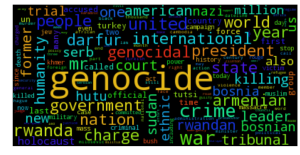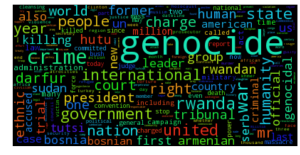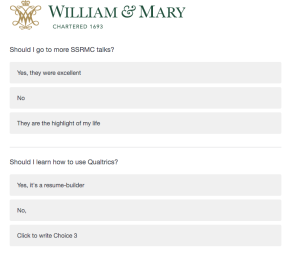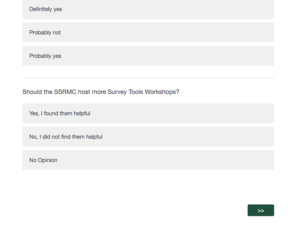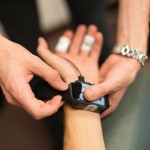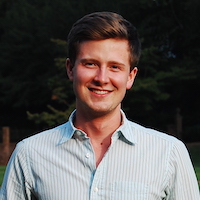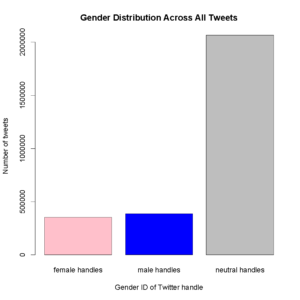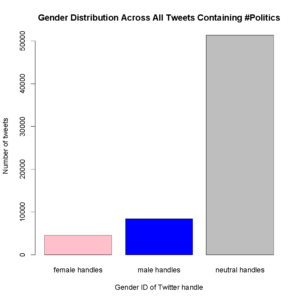Project on International Peace and Security (PIPS)
Published: April 26, 2016 — Written By: Chris DeProspo
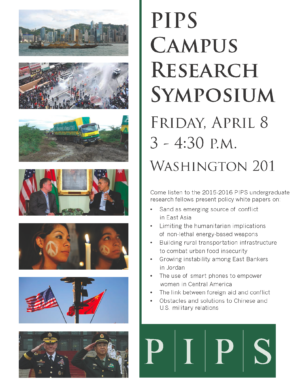
Friday April 8th, 7 the undergraduate Project on International Peace and Security (PIPS) fellows presented their research (white) papers to the William and Mary community, and they will do so again in DC in their upcoming 2016 Policy Symposium. PIPS is a subset of ITPIR, the Institute for Theory and Practice of International Relations. Professors Amy Oakes and Dennis Smith, who run PIPS highlighted the 3 goals of this undergraduate think tank: 1) to tackle difficult international security problems and craft the next generation of foreign policy leaders 2) to make meaningful contributions to discussions in Washington DC and 3) to use undergraduate mentorship to connect the academic and foreign policy fields.
The first paper was Amanda Blair’s “Sand Wars,” a discussion of how sand diplomacy can help ease growing tensions between the US and China in the South China sea. China’s growing infrastructure requires sand and other fine concrete aggregates, which are non-renewable resources. The South China Sea is an area with a large amount of sand, but the growing sand scarcity might prompt antagonistic behavior by the Chinese in this region to attempt to regain this sand; therefore, Amanda recommended that the US support R&D of manufactured sand in Southeast Asia to proactively ease these potential problems down the road?
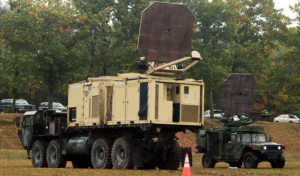
Mitchell Croom then presented his talk on the “Death of Public Protest: Directed Energy Weapons and Their Hidden Consequences.” Croom suggested that, as military technology advances, directed energy weapons are becoming more feasible for militaries, yet the use of military technology can trickle down to police forces. In many ways, his talk paralleled Madison Fox and Samantha Stafford’s research on assault weapons on college campuses, reflecting similar concerns about military technology entering the civilian sphere. This is a particular danger with millimeter wave nonlethal directed energy weapons (N-DEWs), as oppressive regimes can use them to suppress protests and torture civilians since they don’t leave marks. He then suggested regulating N-DEWs for combat use only to inhibit police use of these weapons.
(An example of an N-DEW)
And speaking of protests, Catie Crowley presented her project “Feeding Hungry Cities,” discussing how the growing rural/urban divide in Sub-Saharan Africa can lead to food instability. Specifically, she noted how rapid urbanization creates food insecurity, as rural farmers go from food producers to food consumers. Therefore, poor urban people are at risk for food insecurity and civil unrest, which both threatens democracy and leads to an increase in organized crime. She suggested investing in the failing road networks (which limit food supply and transportation) and expanding the “Doing Business in Africa Campaign.”
In her talk “Silicon Desert- Economic Instability in Jordan,” Caper Gooden also discussed civil unrest and instability, also viewing it as a byproduct of location. She examined the dichotomy between East and West Bankers in Jordan; the former support the monarchy and monopolize public jobs, thereby creating ethnic tensions with the politically-marginalized West Bankers. Given that Jordan is one of few US allies in the Middle East, US policy must ensure that they remain pro-West. Caper suggested that helping East Bankers would help ensure peace in Jordan and with Israel.
Emily Wasek then presented her project “Mobilizing Change in Central America,” which centered around fostering women’s networks to combat gang violence. She argued that mobile phone advocacy is vital to strengthening women’s networks, as mobile phones increase coordination, provide protection, and promote women’s rights. Since the digital age can provide a secure channel for women’s networks, encouraging widespread cell phone use is paramount to this cause. She argues that the US has a vested interest in helping this cause, since transnational gang violence causes regional instability and pushes refugees into the US.
Next, Darice Xue gave one of the more mathematical talks, “Less is More: Emerging Donors, Foreign Aid Coordination, and Conflict.” In the United States, foreign aid is often stigmatized, even though it is preventive rather than reactive and accounts for less than 1% of GDP. She argues that one of the most difficult things about foreign aid contribution is that aid fragmentation has increased, meaning that too many donors have given too little aid. This is turn increases conflict, crowds out the local economy, and feeds corruption, and an ideal level of foreign aid fragmentation would be low.
Finally, mirroring the themes of Amanda Blair’s earlier “Sand Wars,” Jimmy Zhang gave a talk on the importance of US-China military relations. He suggested that the US implement a two-step approach to repairing US-Chinese relations: establishing a foundation for long-term trust and creating formal biannual military talks. Chinese and American diplomatic talks are inhibited by policy on both sides, as China and the US both have policies that limit diplomatic efforts in the other country. He said that the goal of these talks would be to increase trust, suggesting that short term communication was the key to long term trust.
This symposium allowed these undergraduate researchers to present their projects to a group of their peers before they present them to a larger audience at the symposium. Given the depth of their collective research and ability to answer questions in great detail, we at the SSRMC think they will do well. A link to the facebook event for the DC sympostium is here: https://www.facebook.com/events/1669091003351217/
The SSRMC Faculty and Reveley Interdisciplinary Fellowships
Published: April 15, 2016 — Written By: Chris DeProspo
Recently, the Andrew W. Mellon Foundation and President Taylor Reveley awarded two teams with an SSRMC faculty member a Reveley Interdisciplinary Fellowship, a grant given to faculty researchers to aid them in interdisciplinary research. The first team consists of Religious Studies Professor Annie Blazer and Government Professor Jaime Settle; the other team is led by Government Professor Maurits van der Veen and Linguistics/English Professor Daniel Parker).Though the recipients of this award span from STEM to the humanities, Professor Settle was particularly pleased that the College was recognizing the SSRMC faculty and Government department for the interdisciplinary research that they have already been conducting.
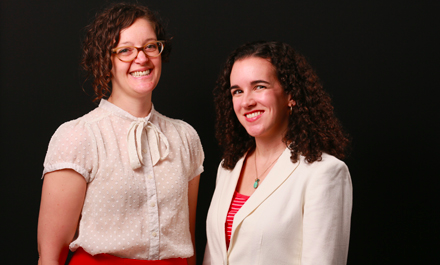
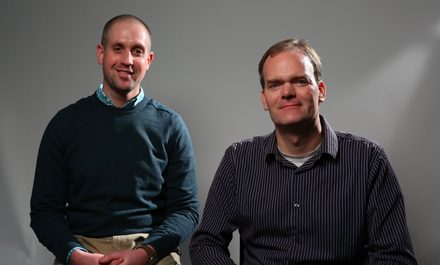
The Foundation wanted to find projects that emphasized the interdisciplinary focus so paramount to a William and Mary education, and per the website: “The Fellows’ projects are focused on integrative and interdisciplinary teaching, as well as a research and scholarship components.”
Professors Blazer and Settle’s project is titled: “Social and Cultural Signaling in Contemporary America.” Professor Settle argues, “Americans signal their political identities in ways that are not explicitly political” and she and Professor Blazer seek to determine “how a bunch of 19 year olds know how to do that.”
The core question motivating their project is “How do contemporary Americans use cultural codes and social signals to infer the religious and political affiliations of their fellow Americans?” Professor Blazer is particularly interested in exploring the growing group of “young nones,” Americans who do not identify with an organized religion at all, most rapidly growing in younger demographics. Professor Settle is especially interested in how liberals and conservatives have different cultural and social preferences that reflect their different moral foundations and policy preferences.
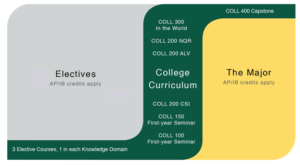
Their research will also create a new three-credit COLL 200 course within the COLL curriculum called “Two Americas: Polarization in Religion and Politics.” Professor Settle suggests this course will add to William and Mary’s commitment to promote “active learning-” the practical applications of theory. Data analysis will be an integral component of this new course, since Professor Settle views data analysis as both a necessary skill and a tool for getting students out of their comfort zones.
Additionally, Professor van der Veen and Professor Parker’s research will also create a new COLL course, based around analyzing big data gathered from a multitude of social media and communicative platforms to find lingual patterns).Professor van der Veen heads the STAIR (Systematic Text Analysis for International Relations) lab, who “use text mining and machine learning tools to analyze and address political issues.”
For example, Professor van der Veen recently wrote about human rights-based news coverage of various genocides, contrasting when human rights news focused on focused on human rights and when it did not (left). He uses these word bubbles to visualize his data, focusing on methods of data collection.
Enter Linguistics and English Professor Daniel Parker, who studies “how we represent and compute linguistic structure in real time.” His background in studying language manipulation serves as a fitting counterpart to van der Veen’s data collection skills, further underscoring his interdisciplinary approach to teaching. And just as Professor Settle aims to instruct students in data analysis, both Professor van der Veen and Professor Parker want to make “computational tools more accessible to non-computer science students.”
As Professor Settle said, “knowledge is not siloed,” and the world is becoming increasingly interdisciplinary. Hopefully, Professor Blazer/ Professor Settle and Professor van der Veen/ Professor Parker’s achievements are the first in the line of many to come, and we at the SSRMC hope that their research paves the way for further interdisciplinary research at the university. To that end, they’re off to a great start.
Survey Tools Workshop
Published: April 15, 2016 — Written By: Chris DeProspo
On Monday March 14th, the SSRMC held a workshop on the study of survey tools, led by Professors Settle and Holmes. The crux of this talk revolved around Qualtrics, a survey creation program that’s both intuitive in nature and available to every William and Mary student with his/her student ID and W&M email address.
Though conducting research through the program can require getting IRB (Institutional Review Board) approval if the project involves human subjects, the actual survey creation through the program is less difficult. Once someone determines a topic to research, they can develop a survey with the touch of a button. During the talk, Professors Settle and Holmes presented examples of doing so, demonstrating how to add questions, develop blocks (sets of questions that one can manipulate in various ways), and create panels (databases of participants that a researcher can track).
The third category is particularly important, since panel creation is one of the primary ways to distribute a survey to a group of people, via email. Though this may seem like a massive undertaking, the Qualtrics mailer allows you to create/title your panel, add participants to the panel, and schedule release times for the survey to be distributed.
To find out how simple this process really was, I ventured over to https://wmsurveys.qualtrics.com/ and followed the requisite steps to create a simple survey. After playing around with the program, I created a survey, which I ask that you complete here.
Hopefully, it becomes clear that this survey has a few problems. To start, all the questions are on the same page, sans page breaks. Not only does the survey not look presentable, but the lack of page breaks is also problematic, as it can create further biases since respondents might see the questions as related to each other. Therefore, Professor Settle suggested adding page breaks to keep participants more motivated to answer questions.
I chose not to preview my first survey and throw it out into the world as-is. Had I previewed my study, I might have noticed that I did not even fill in three responses for the second question. For these reasons, John Stuart, student researcher and director of the Omnibus project, recommended previewing each survey beforehand, which allows you to put yourself in the participant’s’ position (as well as catching any formatting or question/answer mistakes). And if I wanted to track how my participants’ answers changed between the surveys, you can use the aforementioned panels to compare a participant’s changing responses across multiple surveys. Another point of importance was to include “Skip Logic,” which allows you to program the survey’s consent form to skip to the end of the survey if a respondent opts not to participate.
Fortunately, Qualtrics offers solutions for my first survey’s ails. Primarily, it offers the ability to ability to randomize question order, question answer order, and blocks to help randomize my survey. Furthermore, for the first survey, I did not even bother to fill out a third answer for the second question, but a remedy exists here too, as Qualtrics will auto-populate questions by filling in common responses, if necessary.
Here is an improved version of my other survey. Notice that the questions and answers are ordered randomly, though opting for question-order randomization prohibits including page breaks. For my second question about learning Qualtrics, I opted to let the program auto-populate the potential answers, opting for commonly-used options.
For researchers without the luxury of using students as research subjects, they can also utilize Mechanical Turk, which is useful for getting non-student subjects to participate in a study. This service, run through Amazon, allows participants to do small bits of work for small bits of pay, and both businesses and social science researchers can utilize it for research purposes.
-Written with help from Hannah Gourdie, who took notes at the event
New Student Team Profiles
Published: March 18, 2016 — Written By: Chris DeProspo
As it continues to grow, the SSRMC brought on four new members of the student team in early February to facilitate its operations. The collective experience of these new team members mirrors the breadth of research conducted by this organization, and each member is well-equipped to assist the SSRMC in organizing and communicating the research conducted here. The new members’ academic majors span a mixture of foreign language, social science, English, and even computer science, which will allow the SSRMC to achieve the holistic perspectives that W&M strives for.
Furthermore, the organization has a mix of social classes, allowing it to balance fresh perspectives with upperclassmen experience. But different as the members’ interests might be, they stand united toward a common goal: to assist Professor Settle and Professor Holmes in expanding the SSRMC’s potential to levels yet unknown. Each of the new members can be reached at their respective email addresses listed below.
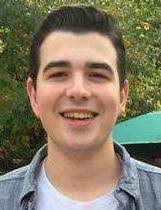
Christopher DeProspo
Christopher DeProspo is an English/Government double major at the college. As a junior, he is well-acquainted with both departments, viewing his position as the technical writer for the SSRMC as the perfect hybrid of these two majors. Since the responsibilities of his position include creating content for the SSRMC blog, broadcasting said content, and helping research students edit their work, he thinks that his writing experience with newspapers like The Flat Hat and The Odyssey will prepare him well. His goal for this semester is to aptly communicate the SSRMC’s work to both William and Mary and the world beyond. He can be reached at cadeprospo@email.wm.edu
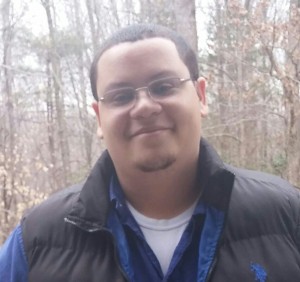
Pryce Fortune
Pryce Fortune is a junior and Computer Science major at
the college, currently working as the new Technical Director for the SSRMC. His goals are to take the website that’s already in place for the SSRMC and “goodify” it as best as he can, thereby making it as accessible to as many users as possible! Furthermore, he is responsible for creating the blog found on the SSRMC website. He can be reached at pcfortune@email.wm.edu

Hannah Gourdie
Hannah Gourdie is a sophomore double majoring in Government and French/Francophone Studies. She hails from Charleston, SC, and she will be working as the Student Director. She looks forward to coordinating both day-to-day operations and events at the SSRMC, as well as helping to expand its presence on campus. Outside of the SSRMC, she is involved in the PPIR Lab, Undergraduate Student Conduct Council, and Swim Club. She can be reached at hrgourdie@email.wm.edu

Amanda Lewe
Amanda Lewe is a freshman at the College who is interested in Government and Economics. Originally from Chantilly, VA, she is working as the Omnibus Student Director and is excited to facilitate social science research within this role. Outside of Omnibus, she is a Tribe Ambassador, member of Kappa Kappa Gamma and InterVarsity and a research assistant for the STAIR lab. She can be reached at aslewe@email.wm.edu
STAIR Profile
Published: February 29, 2016 — Written By: Chris DeProspo
Along with the SNAPP and the PPIR labs, the Systematic Text Analysis for International Relations (STAIR) lab is among the largest of the collaborative research groups affiliated with the SSRMC. The STAIR lab shares not only a workspace with the aforementioned labs but also a broader goal: to communicate social science research conducted at W&M to the campus and world beyond. Headed by Professor Maurits van der Veen, the lab asks for the same communication skills, research abilities, and interest in foreign affairs required by the other labs.
Though these commonalities hint at the overall focus of the SSRMC, the STAIR lab sets forth distinct goals for their research, with an acute focus on language and how it affects both the speaker and his/her audience. In his bio, Professor van der Veen explains his lab’s mission, arguing, “One of the best ways to gauge how someone thinks about an issue is to see how that person speaks or writes about it.” As the technical writer for the SSRMC, his statement aligns with both my personal beliefs and my general approach toward research.
However, van der Veen isn’t just interested in language; he’s interested in discovering trends in it using data analysis. Last week I wrote a piece on R and statistical analysis, and I want to continue that momentum when discussing STAIR’s data gathering techniques. On their website, they state, “we use text mining and machine learning tools to analyze and address political issues.” As far as text mining goes, van der Veen and his undergraduate team utilize software to comb through thousands of sentences to find trends in data. The impact of his research is twofold; he offers an in-depth story about his research and complementary word bubbles to help his audience visualize his research.
This data is both domestic and foreign, although the focus on the former is particularly relevant as we enter the presidential election season. For example, during the 4th Republican presidential debate, opponents criticized Marco Rubio for repeating his message over and over. After researchers confirmed that Rubio’s speech was overwhelmingly characterized by a repetition of his previous points, many voters became more aware of the power of language. At this juncture, Professor van der Veen’s research becomes even more salient.
However, these primaries are a two-way street, and just as the candidates offer nuanced differences in the language they use, so do the media outlets that report on these very candidates. Accordingly, van der Veen’s recent blog posts and research detail his examination of newspapers’ language to determine the underlying differences that they are trying to convey to their readers. For example, one story that caught my eye was about the language that newspapers used to describe Ted Cruz and Donald Trump. After combing through thousands of sentences about each candidate, he compiled word charts in order to demonstrate which terms are more commonly used to describe each candidate (pictured below).
Furthermore, some of the newspapers van der Veen examines are foreign, and the breadth of his research samples allows for him to search for commonalities/ discrepancies between domestic and foreign coverage of the United States presidential race. To demonstrate the differences between foreign newspapers like the Guardian and domestic newspapers like the New York Times, he conducted research about how both newspapers covered Donald Trump, finding that the former’s focus is more general and the latter more specific. These distinctions are visualized below:
Accordingly, the amount of data that STAIR analyzes is beyond the reach of just van der Veen, and a team of undergraduate researchers also conducts research with similar goals. One such project is “Ideology across time and space,” which aims to answer the question of whether political parties in the United States are more polarized than before, using language from Congressional speeches. This specific endeavor is the child of the STAIR and Professor Settle’s SNAPP lab, further underscoring the commonalities between research conducted between the different labs.
Even at W&M, the allure of the STAIR lab extends far beyond the walls of Morton hall. Because the STAIR labs sits at the intersection of linguistics, computer science, and government/public policy, it serves as an apt summation of the very holistic education that William and Mary aims to promote. Further questions can be directed to maurits@wm.edu.
The Value of Learning R
Published: February 28, 2016 — Written By: Chris DeProspo
In the 21st century, the cultivation of analytical thinking skills—the hallmark of the aliberal arts education—should also extend to the ability to collect and interpret data that will yield insights on the core problems facing our society and world. Not all data are quantitative, but more of the world is being quantified. Furthermore, some of the best-paying and most satisfying jobs in today’s economy demand data analysis in addition to analytical thinking and writing skills. These requirements are ubiquitous in many of the post-graduation options favored by W&M alums in the social sciences, and grad school, policy or/ think tank jobs, consulting jobs, and campaign work frequently demand quantitative data skills.
At W&M, data science is increasingly being integrated into the curricula of fields across campus. For example, one of Dr. Dan Runfola’s goals as the geospatial scientist for AidData is melding “data science” and social science curriculums, a worthy endeavor given the growing importance of data analytics in professional and academic spheres.
Furthermore, W&M began offering college freshman the option to take specific data study courses to help prepare students for the world’s increased reliance on data studies.
Statistics courses do not simply lie within the domain of math majors either: Computer Science, Business, natural sciences, and Government majors all need to have a well-rounded understanding of data science to succeed in the professional sphere.
With these aims in mind, Professor Settle has held a series of workshops in learning the software program R, most recently with an “Advanced R Workshop” held the past two weeks. Professor Settle is proficient in R, and her workshop will be a valuable asset to anyone looking to learn this program or become more familiar with it.
Therefore, R is an excellent program for someone looking to become well-versed in data science. Although a number of computer programs are useful for data studies, “R provides an Open Source route to participation in that activity.” The benefits of this nature are listed below.
Why use R?
R is an open source program, meaning that it is both free to users and constantly updated by these same users (they generate new packages and functionalities in the program). Furthermore, R is free to update, so your access won’t disappear or become outdated once you graduate. With that in mind, R is a valuable short and long term asset for W&M students and graduates alike.
Because R is open source, one can easily learn about it online, as a vast amount of information can be found on its website and beyond(https://www.r-project.org/). Gaining an intermediary knowledge of R is not a hefty investment, but it is valuable. The R website lists a number of R’s benefits: “As an interactive language, R promotes experimentation and exploration, which improves data analysis and often leads to discoveries that wouldn’t be made otherwise” (https://www.r-project.org/). For a researcher looking to differentiate his/her research, R is an excellent avenue to do so.
Furthermore, R is flexible. Many jobs centered on social science degrees favor quantitative data analysis, and people from a wide variety of disciplines use it and have developed tools and applications for it. For an undergraduate or graduate student interested in a career involving quantitative data, R is a resume-builder, one with a wide range of benefits.
On the visual side, R makes beautiful graphics, and with R, you can produce a wide variety of powerful visualizations to complement the data you gathered in order to tell a story.

(Credit: http://screenshots.en.sftcdn.net/en/scrn/69000/69379/3_Untitled_7.jpg)
Given that R is both widely-used throughout the professional and academic world and can be quickly learned by its users, W&M students should take advantage of the SSRMC’s resources to learn R.
Profiling the Omnibus Part 4: The Scope and Scale of the Project
Published: December 18, 2015
The SSRMC has seemed strangely quiet since the last Omnibus Project research subject of the semester passed through its doors on December 4th. Between October 15th and the last day of classes, 369 subjects spent an average of 45 minutes in the SSRMC as research subjects. The center was the site of 30 hours of proctoring each week, and two proctors were needed to run the project at all times. All told, research assistants affiliated with the project spent more than 500 hours executing it, an enormous undertaking.
Three students benefitted directly from the ability to collect their own data for their honors theses. In a survey experiment, Duenya Hassan sought to measure the effectiveness of counter-narratives to reduce the appeal of terrorist groups. Ming Siegel studied the rise of the religiously unaffiliated in the United States, a term that Pew Research reports have applied to atheists, agnostics and Americans who affiliated with nothing in particular. The Omnibus Project allowed her to survey college-aged Millennials, who are statistically more likely to be religiously unaffiliated than members of older generations. John Stuart’s honors thesis looks at the role emotions play in support or opposition for certain political policies. Omnibus participants answered survey questions online about their political attitudes, behavior, and ideology. Following this they came into the SSRMC and were hooked up to equipment that measured how they responded physiologically to stimuli (photos and videos) that triggered specific emotions.
The Omnibus would not be possible without the participation of classes in the government department. This year, 12 faculty members incentivized their students to participate. Participation rates were very high: 87.4% of the 178 eligible students who were required to participate did so, as did 63.6% of the 352 students who were eligible to receive extra credit for their participation.
During the spring 2016 semester, the Omnibus will be conducted entirely online. In lieu of proctoring in the lab, the SSRMC will host workshops on learning the skills necessary to conduct research on the Omnibus, including using the software program Qualtrics and best practices for survey design.
Profiling the Omnibus Part 3: A Conversation with the Fall Faculty Director, Jaime Settle
Published: December 7, 2015
While the student director of the Omnibus Project is largely responsible for its day-to-day operations, each semester, one of the co-directors of the SSRMC helps oversee the project and serves as a liaison with the faculty. This semester, Jaime Settle served in that role. We spoke with her about the origins, benefits, and future trajectory of the Omnibus Project.
Q: What was your inspiration for starting the Omnibus project?
A: Political science departments that have graduate programs often have subject pools similar to the Omnibus, and when I was a graduate student at UC San Diego, my advisor and a friend of mine were the ones responsible for getting it started there. I’d seen what a difference it made for graduate students at UCSD, and I thought it could be equally valuable here, given the high quality research project ideas that W&M students develop. There had already been interest in this idea before I arrived, and other professors in the department were very supportive of it, so all that was needed was to get it off the ground.
Q: What were some of the biggest hurdles or problems you faced in getting the Omnibus off of the ground?
A: I would say that without the financial support of the Government Department and the Charles Center and the encouragement and involvement of my colleagues, the project wouldn’t be possible. All of the researchers who use the Omnibus are very appreciative of the extent to which it has become institutionalized in the department.
Administering a student subject pool with over 500 eligible subjects a semester is a very logistically complicated endeavor, and the bulk of the task is carried out by the student director each year. We’ve been fortunate to have incredibly bright, organized and detail-oriented student directors so far, but I’d say that identifying students who are a good fit for the position is one of the most important and potentially challenging aspects of the project.
Q: How has your students’ research benefited from the Omnibus?
A: Tremendously! Four of my five honors students have used the Omnibus to collect data for their own work, in addition to several students working with other faculty members over the past few years. Designing an experiment and collecting data makes for an extremely time intensive honors project, but the payoff can be very high: one of these projects currently has a “revise and resubmit” at a well-respected journal, and two others have won the Warner Moss Prize for the most outstanding thesis in the department. Most importantly, I think the presence of the Omnibus encourages student creativity and stimulates student interest in doing independent research because the work of their peers becomes more visible and accessible.
Q: How does the Omnibus change the way that W&M students do research?
A: W&M students are able to ask research questions and design projects that would otherwise be infeasible. While there are many legitimate criticisms about how results found in a convenience sample of undergraduate students can generalize to the broader population, there is no replacement for having an easily accessible pool of subjects for conducting experiments. Experimental research can be a very costly endeavor, and the Omnibus Project reduces those costs for individual researchers to “lower the barrier to entry” for collecting data.
Q: What is the future direction of the Omnibus? What is the big picture plan over the next few years?
A: I think the longer term vision is to further develop the infrastructure of the project so that we can accommodate more research proposals each year. Ideally, we’d have more students involved in the administration of the Omnibus so that we could collect data in the lab during both semesters. I would also say that we’d like to be able to better accommodate faculty who are interested in collecting data as part of a class project. To date that has been difficult because of timing issues, but in the future, I’ think that would be a real service to the department.
Profiling the Omnibus Part 2: A Conversation with the Student Director, John Stuart
Published: November 10, 2015
For the second installment of our series profiling the Omnibus Project, we spoke with the Omnibus Student Director, John Stuart. John is senior at the College, double majoring in Government and Linguistics.
As the Student Director, John is the behind-the-scenes force that drives the Omnibus. From creating the protocol for proctoring experiments, to scheduling participants, to disseminating the data back to researchers, John has a hand in it all. His work is critical to the success of the Omnibus. He was kind enough to take the time out of his busy schedule to have the following conversation about his role.
Q: How did you become Student Director of the Omnibus Project?
A: I became the Student Director of the Omnibus Project due to my previous involvement in the SNaPP Lab. Though I became the Student Director in the Spring 2015 semester, I had performed various tasks that make up some of responsibilities of the Student Director…prior to assuming the position. The previous summer, Professor Settle (the Director of the SNaPP Lab and co-Director of the SSRMC) was conducting pilot testing of a research study with older Williamsburg community members serving as study participants. I had handled distributing online surveys to these individuals as well as scheduling them for in-person lab sessions. Additionally, during the Fall 2014 semester the SNaPP Lab research team that I was on assisted a different Omnibus Project student director with some aspects of the role, such as the logistics of the proctoring schedule and the scheduling system by which students booked times to come into the lab. In many ways, becoming the student director of the Omnibus Project was a natural continuation of past work I had done in the lab.
Q: How many studies are currently being run from the Omnibus?
A: The Omnibus this semester is collecting data for six studies, from three faculty members and three honors students (myself included in the latter group).
Q: What’s a day in the life of the Student Director like?
A: That’s a really tough question to answer! It really depends on what part of the semester it is. Earlier on [in the Fall], I might be programming project proposals that we’ve received into Qualtrics, the online survey platform we use for part of the Omnibus data collection. After this I communicate back and forth with the researchers whose projects are included in these surveys to make any tweaks or adjustments that are needed. Another day early in the semester could see me pulling together the proctoring schedule if there are studies running that require a lab portion (as usually occurs in the Fall semesters). It’s basically a game of logistical Tetris, but it all works out in the end! The last main early-semester duties the student director fulfills is setting up the online booking system for the included lab studies and drafting the emails that go out to students in participating Government courses.
I also sometimes get asked by faculty with courses participating in the Omnibus to speak to their students about the Omnibus Project, both in terms of what their students will need to do to participate and about the research process as it relates to the Omnibus Project as a whole. Later on in the semester, my main role is pulling together daily schedules for Omnibus participants that come into the SSRMC for lab sessions and sending out reminder emails, and checking the completion rates on the online surveys we’re fielding. Once classes end for the semester, I separate all the data collected into the datasets that will go to each of the researchers for their individual project (anonymizing the data in the process).
Q: What’s the best part of your job?
A: Despite the unglamorous nature of some of my duties, seeing “behind the curtain” into how this sort of research is executed and how one goes about collecting data for it can be fascinating. The best part of my job is knowing that the Omnibus Project provides a “public good” to students and faculty within the Government Department (and related fields). Without the Omnibus, executing survey and lab-based social science research within the Department would be much more difficult, especially for undergraduate students. The ability to facilitate this sort of research makes the work incredibly meaningful for me, whether it’s for an undergraduate honors thesis, for faculty projects that are being pilot tested, or for faculty projects that are fully fleshed out with an eye to being published based off of the data they collect through the Omnibus.
For more information about the Omnibus Project, visit this link.
If you are interested in submitting a research proposal to the Omnibus Project, visit this link.
What do data science and a liberal arts curriculum have in common?
Published: November 9, 2015
Despite what you might think, they are both a part of the William & Mary experience. Dr. Dan Runfola, the geospatial scientist for AidData at William & Mary, is bringing “data science” to even the humanities and social science students of the College. With the growing industry of data analytics, being able to understand “big data” and how it affects everyday life is becoming increasingly important for the educated population. Big data is relevant in everything from the way our social media platforms operate to how political campaigns target voters to how aid is sent to the areas that need it most. In order to have the greatest impact on the world, college students are going to need to understand the vital concepts that come with thinking about it in a new way. Dr. Runfola’s potential data science minor and its accompanying test case and requirement, a new COLL 100 course, will be able to help.
Although the data science minor is still in the negotiation phase of becoming a reality, Dr. Runfola described some of its key points and the reasoning behind its conception. Primarily, Dr. Runfola needed student researchers for his team when he came to William & Mary in 2014. W&M students are clearly motivated individuals and interested in getting involved, but Runfola noticed a lack of research skills he would usually find in the student body of a college or university with an emphasis on engineering and similar programs. His goal was to prepare students for research opportunities stemming from his role with AidData and his prior experience with large research labs at UC Boulder. He thought about what students would need that was not already available to them, and used the Mason School of Business classes on data in the business as a model during the brainstorming phase to address these gaps. He emphasized that the minor would not create “experts” in the data science fields, but rather students that are familiar enough with key concepts to assist true experts in solving complex problems.
The COLL 100 data course forms the foundation for the data science minor, and is similar to the currently-offered INTR 100 course, “Breaking Intuition.” The course will introduce students to the “big idea” of data science as well as multiple forms of conducting research. It is set up in two-week modules, with each portion devoted to a specific kind of research taught by a professor who is an expert in that field. Students will be exposed to varying ways of using data and will be able to practice the respective research strategies through workshops and labs. Examples of the broad range of topics that data science can be (somewhat surprisingly) relevant to include social justice, the human mind’s tool of intuition, and the effect of algorithms on human behavior. Thus, the COLL 100 course is intended not to attract people already prepared to be computer scientists, but people who have other interests in areas like the environment or psychology or government or, really, anything else. The course will accompany other courses that touch on basic computer science skills, statistics, and probability knowledge, and will be followed by the COLL 200 course that will allow students to partner with actual groups and organizations (what Dr. Runfola called “decision makers”) to conduct research projects in a real world context. These courses and the data science minor will combine a liberal arts background with an introduction to how to think about data in real life, potentially producing some of the world’s most effective and well-equipped problem solvers.
Profiling the Omnibus: Part One
Published: October 25, 2015
This week will begin a multi-part series profiling the SSRMC’s Omnibus Project. The first installment of the series will briefly explain the project and include a brief interview from the project’s newest proctors.
Established in 2013, the Omnibus Project coordinates and streamlines the development of a student subject pool for faculty and student research in the government, public policy, and international relations programs. Researchers can submit project proposals for data collection that are incorporated into the project. Because the Omnibus Project collects data from a pre-existing subject pool, it reduces the administrative hoops researchers must jump through to generate original data. The project has made it easier for student and faculty researchers to carry out original research due to the accessibility of a sizeable subject pool.
Multiple researchers gather data from the Omnibus Project simultaneously. Last year, for example, there were seven student or faculty projects; this year we anticipate at least ten. In order to facilitate data gathering, student proctors are needed to greet subjects when they arrive and guide them through the various protocols taking place each semester. Student proctors are able to gain experience with conducting academic research by administering the Omnibus to the subject pool.
Emily Jackson and Alex Valorose are two new proctors for the project. Both sophomores involved in the PPIR lab, these students recently went through proctor training, led by John Stuart and Edward Hernandez of the SNaPP Lab. Emily and Alex were interviewed during their first official day as proctors. Both agreed that the first day of leading subjects through the Omnibus was stressful. However, with a little practice they believe everything will continue to run smoothly. The initial stress was soon outweighed by both students’ excitement for the upcoming semester of proctoring. Emily Jackson noted how the Omnibus simplifies data collection for all researchers who use it: “It’s cool that so many people are getting so much data from the same project.”
As the semester progresses, the SSRMC will see hundreds of student participants pass through its doors to participate in the Omnibus Project. Data collected by the project and synthesized by the director, John Stuart, will contribute to the research of individual projects, honors theses, and faculty research.
The next installment of the Omnibus profile will include an interview with Student Director John Stuart!
SSRMC Summer Research Students Present Work
Published: October 13, 2015
This summer, eight students completed summer research projects stemming from their work in research groups affiliated with the SSRMC. The final products of their summer research were on display at the Roy R. Charles Summer Research Symposium September 28th through October 2nd. Although the actual poster presentation is just two hours long, the summer research process consists of multiple semesters and requires serious planning and execution. Many SSRMC students began drafting their ideas for summer research the preceding fall semester and worked diligently throughout the spring to further develop their research plans.
SSRMC students covered a wide variety of topics over the summer. Several students describe their research in their own words:
Zarine Kharazian ‘17: “This summer, I conducted a survey experiment to assess whether social endorsement of a political opinion – in this case, on the Ferguson grand jury decision – on an online social network discourages individuals who hold the minority opinion from expressing their view. The project serves as the first study within a larger research effort to 1) develop standard operational definitions for common Facebook behaviors and identify their real-life counterparts; and 2) fully assess the relationship between individual personality traits and online social behavior.”
Yussre ElBardicy ‘16: “This summer, I spent time in the SNaPP Lab working on my honors thesis, titled “A Content Analysis of Egyptian Newspapers.” The data retrieval proved to be extremely difficult due to the nature of many of the newspaper archives as well as the semantic differences between the Arabic and English languages. Thus, I’ve had to overhaul my research design a bit, but I’m making progress!”
Emily Draper ‘16: “During the summer, I began investigating the relationship between gender and agreement in online political discussions. My summer was devoted to analyzing the some 400 million tweets for author gender. The next phase in my research will involve using the Linguistic Inquiry Word Count program, an automated word counting software, to analyze the tweets for agreement.
The first graph shows the gender breakdown for number of tweets in the dataset.” Note the similarity in tweet number between male and female Twitter handles. “The second graph shows the gender breakdown for number tweets that contain the hashtag ‘#politics’.” Here we see a much larger disparity between numbers of male versus female Twitter handles using this hashtag.
Summer research provides students with an opportunity to dive headfirst into a research topic of personal interest, exploring their topic in much more depth than they would in a class or during the semester. Over the summer, students can give their undivided attention to their research and work to create a deliverable of their research covering their progress throughout the summer. These students in particular used summer research as an opportunity to further their long-term research goals, like more in-depth individual projects or honors theses.
As the SSRMC continues to grow, encompassing more research labs and providing training on a wider variety of research methods, the center will continue to support and enable students to pursue summer research opportunities. For students interested in pursuing summer research funding through the Charles Center, please see this link for further instructions.
SSRMC Annual Report is Published
Published: September 7, 2015
The Social Science Research Methods Center recently published an annual report after completing its inaugural year. The report details every aspect of the SSRMC from the collaborative research focused mission to profiling the individual research labs within the center. The SSRMC has seen impressive growth over the past year. Beginning as an abandoned section of the Blow Hall basement, the center has become the bustling home of 46 students who receive academic credit for their research. Currently, the SSRMC is host to three research labs with three separate faculty advisors. The Social Networks and Political Psychology (SNaPP) Lab run by Professor Jamie Settle aims to explore “the biological, psychological, and social underpinnings of political behavior”. Also within the center is Professor Marcus Holmes’ Political Psychology and International Relations Lab, which provides students with the opportunity to explore their interests in international relations through the lens of psychology. Last is Professor Paul Manna’s Research Team. This research group collaborates with researchers from Brown University to study state level education policies.
One of the highlights of the Annual Report is the Omnibus project. The Omnibus helps to “streamline” a student subject pool for research projects conducted by both W&M faculty and students working on research projects or honors theses. The Omnibus subject pool is comprised of undergraduate students in government classes. This initiative gives researchers the opportunity to tap into a ready-made subject pool without having to jump through the hoops involved in collecting original data.
Although the professors who operate within the SSRMC are all from the government department, students in the center have a variety of different majors and interests. Aside from several Government and Public Policy majors, the center is home to students majoring in Computer Science, Linguistics, Psychology, English, Math, Economics, International Relations, and Environmental Science. Students from all academic backgrounds who are interested in building their analytical social science research skills have found a diverse and welcoming research environment in the SSRMC. Collaborating with faculty who are interested in helping students pursue their research passions lets students learn experientially by cultivating original research questions and projects. This research-based learning gives students the opportunity to apply theories and ideas they learn about in class to real research questions. In pursuing their own research interests, students become more invested in their projects and develop analytical skills that cannot be taught in the classroom.
The Annual Report in its entirety can be found here.
SSRMC Hosts Open House
Published: September 7, 2015
Last Friday, September 11, 2015, students in research labs, in independent study programs, and conducting honors theses came to the SSRMC for the first annual fall Open House. The faculty and student directors of the SSRMC welcomed the students with tours of the space, introductions to the SSRMC website and room reservation system, and of course, some edible incentives from Sal’s and copious amounts of Sprite left over from a previous SNaPP lab experiment.
Students came from all sorts of backgrounds in social sciences. The students utilizing the space range from Professor Settle’s political psychology (SNaPP) lab to Professor Holmes’ international relations-focused group. Professors van der Veen, Manna, and Rapoport have student researchers working on still more social science topics. However, research assistants are not the only people who will use the SSRMC this year. The students walking into the SSRMC during the Open House could simply be self-motivated students embarking on their own independent research journeys. Every time a new face came through and we learned why he or she was there, we were given the opportunity to emphasize a different part of the space that would be particularly helpful to them. SNaPP lab members were re-familiarized with the physiological experimentation suite, other groups received emphasis on the whiteboard-painted collaboration rooms ideal for diagraming big ideas, and independent researchers were shown the cozy individual study room that may add some comfort to the hours spent brainstorming the perfect thesis statement.
The broad spectrum of research involvement seen throughout the Open House was representative of exactly what the SSRMC is meant to be: a true home for the social sciences on campus. Multiple students expressed excitement about finally having a place they could call “theirs,” sometimes making direct comparisons to the presence of the ISC for students of the hard sciences. No longer are social science researchers relegated to a cramped room of Morton or forced to find space among the crowded tables of the MEWS café. They now have a place to work both on their own projects and among others interested in the same kind of world-altering questions, fostering William & Mary’s next integrated community of social science scholars.
Deadline for Omnibus Project Proposals
Published: September 6, 2015
The deadline to submit proposals for the Fall 2015 Omnibus Project is this Friday, September 11th. Applications are being accepted from Government, Public Policy, and International Relations majors and faculty. Experiments and surveys will be run from October through December 2015.
The Omnibus streamlines a student subject pool for social science research. The subject pool is made up of undergraduate students enrolled in a government class.
Applications can be found here
Please send all completed applications to John Stuart at: wmgovtomnibus@gmail.com.
